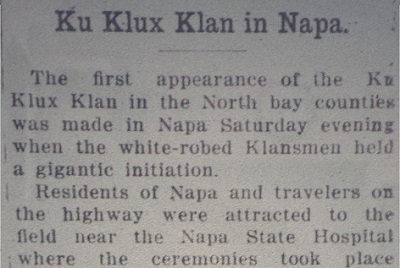African American History, Ask A Librarian, California History, Napa, St Helena
Ask a Librarian: The KKK in Napa
Is it true that there were KKK rallies in Napa?
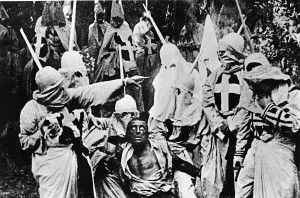
The Ku Klux Klan saw a great resurgence after its reestablishment in 1915, heralded in part by D. W. Griffith’s Klan homage film Birth of a Nation. Many Americans were fearful of the violent and chaotic events taking place on the world stage and reacted by adopting isolationist rhetoric.[1] This overinflated sense of patriotism coupled with unsubstantiated xenophobia was fueled by the rapid influx in immigrants. The KKK latched onto that paranoia.
Where the old guard used terrorism to enforce Redemption (the period after Reconstruction where Southern Democrats reinstituted their pre-Civil War power structures), the reborn Klan looked beyond white supremacy and “championed themselves as defenders not of a racial or caste system but of traditional values. This vision allowed the Klan to win the support of people who would not normally have supported it. New recruits saw modernization, not just racial minorities, as a threat to their traditional ways of life.”[2] Before its collapse in 1928, the KKK had from two to five million members throughout the country, at least half in cities with populations exceeding 50,000. Their Western membership included the governors of Oregon (Walter M. Pierce, 1923-1927) and Texas (Dan Moody, 1927-1931), and the mayor of Denver (Dewey C. Bailey, 1923-1931).[3]
In Napa County, Italian, German, French, and Swiss immigrants flocked in the 1880s through 1920s, so much so that Napa City even had its own “Little Italy.” In the decade between 1870 and 1880, the county-wide population nearly doubled from about 7,600 to just over 15,000, and by 1920 jumped again to over 20,000. Many of these immigrants worked in the wine industry and suffered the hardest during Prohibition, typically from bootlegging arrests and the loss of their family fortune that had been tied up in grapes.

The Klan held two major rallies in Napa County in the 1920s, both of which were covered by the St. Helena Star. The Klan attracted a handful of followers in Napa during the few years they managed to keep a chapter active. The first rally took place on October 20, 1923, in a field near Napa State Hospital. For two hours, 200 Klansmen paraded around “like phantoms in the moonlight.”[4] Of the participants, more than 100 were initiated into the order, including 25 Navy seamen from Mare Island. Those sailors likely interacted with some of the Black Napans who did the manual labor at the shipyard in the 1920s, men like Jackson Bell, a rigger, Isaac Barnes, a roadworker, and Chester and Frank Patterson, general laborers. The Star estimated 2,000 spectators watched the rally from a nearby hillock as the Klan lit a 20-foot tall cross on fire.[5]
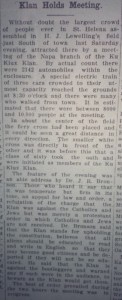
On August 2, 1924, another rally was held, this time near St. Helena in a field owned by H. J. Lewelling. This time 8,000 to 10,000 onlookers goggled at the proceedings. The Napa chapter even rented a three-car electric train for the journey to celebrate the initiation of 60 new members. The keynote speaker, Dr. J. Rush Bronson, a notable KKK lecturer, gave a “temperate but firm” speech that was “an appeal for law and order, [and] a refutation of the charge that the Klan was against the Catholics and Jews but was merely a protestant order in which Catholics and Jews are not received” (a distinction Napa Catholics and Jews likely found rather meaningless in practice). He went on to insist that “the Klan stands for upholding the constitution, believes that all aliens should be educated to read and write in English so that they may be good citizens and be deported if they will not be so educated. He said that the Klan is against the bootleggers and warned any if such were in the audience, to beware as the Klan would get them.”[6]
Between 1923 and 1924, the Ku Klux Klan initiated at least 160 people in Napa County – four times the number of African Americans recorded on the 1920 federal census. What attracted Napans was less the violent racism and bigotry against people of color, Catholics, and Jews (the county had long-standing, fairly good-sized populations of all three groups), and more of the conservative moral imperatives they preached. The Klan’s opposition to taxation and frustration with unassimilated immigrants struck a chord with traditionalists. Despite earning much of its agricultural revenue from wine, many Napans were teetotalers who voted “Dry,” disdained the non-protestant “huddled masses yearning to be free” who worked in the fields and factories for little pay, and loathed bootleggers, especially recent Italian immigrants who were unlucky enough to be poor, Catholic, unwilling to shed the cultural traditions of their homeland, and unable to comprehend Prohibition as a moral imperative.
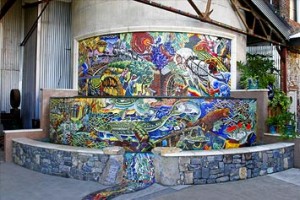
Fortunately, Napa’s period of active Klan activity was relatively short-lived. Unlike some cities in California, Napa’s KKK chapter did not control or even greatly affect local politics. The Klan very nearly died out in the late 1920s after David Stephenson, the head of the Indiana branch who was accused of raping his secretary and causing her suicide, revealed the organization’s vast corruption. In Napa, the excitement was over and the spectacle had lost its curiosity. A Klansman ran for Napa city council in 1926 but lost handily. Today, a controversial mosaic at Napa Mill marks this dark period in our county’s history.
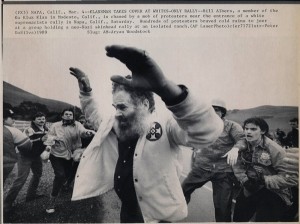
In 1989 the White Aryan Resistance attempted to hold a white supremacist “Woodstock” on private land in the Jameson Canyon area of southeastern Napa County. For days leading up to the event, Napans were up in arms over the festival. The protest spurred the creation of a new community group, Citizens Against Racism, while white supremacist Tom Metzger, founder of the White Aryan Resistance and the festival’s biggest supporter, countered “that the affair was ‘invitation only,’ that he was ‘not here to argue or discuss our ideas’…But John Hughes asked the Supervisors not to let him ‘hide behind freedom of speech,’ saying that he had ‘no right that causes others to commit violence against minorities’.”[7] Metzger’s words sounded strikingly similar to those of Dr. Bronson in his speech at the Napa KKK rally in 1924. Also similar to the 1920s rallies, neither the white supremacists nor the news reports indicated any interest in the nearly 1,100 Black Napans. The Napa County Superior Court won a temporary injunction against the festival, and although the rally eventually took place, it was barely attended, achieved nothing, and the group never came to the county again.
[Ed. note: this article is excerpted in part from the master’s thesis “There Are No Black People in Napa”: A History of African Americans in Napa County by Alexandria Brown.]
[1] Kristen Anderson, “Nativism, 1890-1930,” in Elizabeth Faue and Gary B. Nash, eds. Encyclopedia of American History: The Emergence of Modern America, 1900 to 1928, revised edition, (New York: Facts On File, Inc., 2010) American History Online, http://www.fofweb.com.
[2] Steve Freund, “Ku Klux Klan (KKK), 1866–1925,” in Elizabeth Faue and Gary B. Nash, eds., Encyclopedia of American History: The Emergence of Modern America, 1900 to 1928, revised edition (New York: Facts On File, Inc., 2010), American History Online, Facts On File, Inc., http://www.fofweb.com.
[3] Kenneth T. Jackson, The Ku Klux Klan in the City, 1915-1930 (Chicago: Elephant Paperback, 1992), Kindle Electronic Edition: Foreword to the 1992 Edition, Location 41.
[4] “Ku Klux Klan in Napa,” St. Helena Star, October 26, 1923, microfilm.
[5] Ibid.
[6] “Klan Holds Meeting,” St. Helena Star, August 8, 1924, microfilm.
[7] “Supervisors Handle ‘Woodstock’,” Napa County Record, March 2, 1989, Ephemera Collection, Napa County Historical Society.


